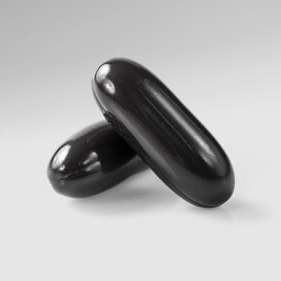BACKGROUND
Ingredient Type: Botanical, Extract
Also Known As: Celastrus paniculatus, Malkanguni, Staff tree, Intellect plant, Climbing staff plant, Black oil plant

Jyotishmati is an ancient Ayurvedic plant valued primarily for its health benefits. It is a shrub that grows at high elevation (usually above 3000 feet) primarily in India. Jyotishmati leaves have been described as having the shape of a pigeon’s foot, while their fruit is said to look like a crow’s egg. Oil, extracted from the fruit, is used for healing purposes (5).
Tribal systems of medicine in different regions of India have claimed the use of Jyotishmati oil in the treatment of a wide range of disorders. It is frequently used as brain tonic due to its purported effect on memory and intellect. The phytochemicals present in Celastrus paniculatus include sesquiterpenes, alkaloids, cleastrine, celapanine, celapgine, and polyalcohol (malanguinin, malkanginnol, etc.). It also contains the triterpenoid pristimerin, and sterols (β-amyrin and β-sitosterol) (16).
TRADITIONAL USES
Jyotishmati is used in Ayurveda as a bitter digestive tonic and to enlighten the mind. The fruits and seeds are used in health supplements today to support cardiovascular and mental function.
Extracts from the plant are also believed to have anti-arthritic, wound healing, hypolipidemic, and antioxidant activity (2).
Other traditional therapeutic uses include (1,3,5):
- To improve intelligence
- To balance Vata and Kapha
- To induce vomiting
- To improve digestion
- To improve memory
- To relieve constipation
- To help with anemia and liver disorders
- As a cardiac tonic
WHAT DOES SCIENCE TELL US?
- Jyotishmati seed extract possesses significant antinociceptive and anti-inflammatory activity (2).
- Celastrus paniculatus seed oil was the most effective in preventing neuronal cells against H(2)O(2)- and glutamate-induced toxicities. Thus, in addition to free-radical scavenging attributes, the mechanism of CP seed component (CP-C) neuroprotection must be elucidated (9).
- The aqueous extract of Celastrus paniculatus seeds has cognitive-enhancing properties that may be due to an antioxidant effect (10).
- Celastrus paniculatus extract seems to exert a powerful myogenic and L-type Ca(2+)-dependent relaxing effect. This could explain the traditional use of this herb in the treatment of intestinal spasms (11).
- Jyotishmati seed extract possesses significant antinociceptive and anti-inflammatory activity (14).
SAFETY
Single oral administration of different dose levels produced no mortality or morbidity in animals during an observation period of 14 days. Cage-side observations showed no change in general appearance and morphological characteristics of animals. There were also no significant changes in body weight, food, and water intake in extract treated animals when compared with control animals (16).
No adverse events in humans have been reported in the current scientific literature. As with most herbals, however, caution is advised and use thereof should be avoided during pregnancy or breastfeeding (17).
REFERENCES
- https://easyayurveda.com/2012/12/05/jyotishmati-medicinal-qualities-ayurveda-benefits-and-dose/
- J Ayurveda Integr Med. 2015 Apr-Jun; 6(2): 82–88.doi: 10.4103/0975-9476.146540 PMCID: PMC4484053 Effect of Jyotishmati (Celastrus paniculatus) seeds in animal models of pain and inflammationYogesh A. Kulkarni, Sneha Agarwal, and Mayuresh S. Garud
- Monojit D, Reshmi P, Harshita K, Nishteswar K. Medico ethnobotanical perspectives of jyotismati (Celastrus paniculatus Willd): A herbal tranquilizer. J Drug Deliv Ther. 2012;2:8–11.
- Basu NK, Pabrai PR. Chemical investigation of Celastrus paniculatus Wild. J Am Pharm Assoc. 2006;35:272–3
- Patel DK, Amin KS, Nanavati DD. Chemistry and pharmacology of Celastrus paniculatus Wild. Indian Drugs. 1995;32:566–73.
- Yasu LU, Yang S, Zou Z, Chen H, Zhen X, Zhongemei Z, et al. Evoninoate sesquiterpene alkaloids from the stem of Celastrus paniculatus. Heterocycl. 2006;68:1241–7.
- Katekhaye S, Duggal S, Singh AP. An inside preview of the nutritional and pharmacological profile of Celastrus paniculatus. Int J Recent Adv Pharm Res. 2011;1:19–24.
- Mathur NT, Varma M, Dixit VP. Hypolipidaemic and antiatherosclerotic effect of Celastrus paniculatus seed extract in cholesterol-fed rabbits. Indian Drugs. 1993;30:76–82.
- Godkar PB, Gordon RK, Ravindran A, Doctor BP. Celastrus paniculatus seed oil and organic extracts attenuate hydrogen peroxide- and glutamate-induced injury in embryonic rat forebrain neuronal cells. Phytomedicine. 2006;13:29–36.
- Kumar MH, Gupta YK. Antioxidant property of Celastrus paniculatus wild: A possible mechanism in enhancing cognition. Phytomedicine. 2002;9:302–11.
- Gattu M, Boss KL, Terry AV, Jr, Buccafusco JJ. Reversal of scopolamine-induced deficits in navigational memory performance by the seed oil of Celastrus paniculatus. Pharmacol Biochem Behav. 1997;57:793–9
- Borrelli F, Borboneb N, Capassoa R, Montesanoc D, Marinob S, Aviello G, et al. Potent relaxant effect of a Celastrus paniculatus extract in the rat and human ileum. J Ethnopharmacol. 2009;122:434–8.
- Atigari DV, Gundamaraju R, Sabbithi S, Chaitanya KB, Ramesh C. Evaluation of antiepileptic activity of methanolic extract of Celastrus paniculatus wild whole plant in rodents. Int J Pharm Psychopharmacol Res. 2012;2:20–5.
- Patil KS, Suryavanshi J. Effect of Celastrus paniculatus, wild seed on adjuvant-induced arthritis in rats. Pharmacogn Mag. 2007;3:177–81.
- Phytochemistry. 2013 Oct;94:211-9. doi: 10.1016/j.phytochem.2013.05.022. Epub 2013 Jun 27. Cytotoxic constituents from Celastrus paniculatus induce apoptosis and autophagy in breast cancer cells.Weng JR1, Yen MH, Lin WY.
- Effect of Jyotishmati (Celastrus paniculatus) seeds in animal models of pain and inflammation J Ayurveda Integr Med. 2015 Apr-Jun; 6(2): 82–88. doi: 10.4103/0975-9476.146540
- https://herbpathy.com/Uses-and-Benefits-of-Celastrus-Paniculatus-Cid807
See the Examine.com entry for Celastrus paniculatus for more information.









